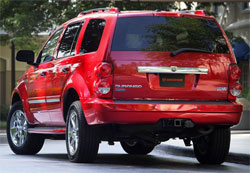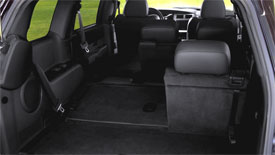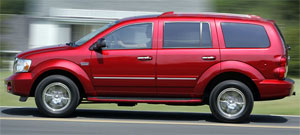2009 Dodge Durango HEMI Hybrid
If large body on frame SUVs have any hope of staying around, it has to be through better fuel economy, especially for city driving. That’s the story behind GM’s Chevrolet Tahoe Hybrid and GMC’s 2008 Yukon Hybrid. And it’s the same approach Chrysler is taking for its big SUVs like the new Durango HEMI Hybrid. But even with this greener game plan, are a few more m.p.g.‘s enough to keep these former favorites from fading away completely?
Chrysler’s efforts to stem the downward tide of big SUV sales is being spearheaded by both the 2009 Dodge Durango HEMI Hybrid, and its cousin, the Chrysler Aspen HEMI Hybrid. Moreover, these large all-wheel drive full-hybrid SUVs are the automaker’s first hybrids. They result from the joint venture with GM, Mercedes-Benz, and BMW and utilized the General’s highly publicized two-mode hybrid transmission.
As its name implies, the Durango’s hybrid system includes a 5.7-liter HEMI V8. Output is 345 horsepower and 380 pound-feet of torque. To mitigate fuel use further, the HEMI includes Multi-Displacement System which shuts down four of the eight-cylinders when less power is needed.
 Like Tahoe, the two-mode transmission includes two AC synchronous electric motors. ‘Two Mode’ means these motors can provide continuously variable assistance at both city and highway speeds. The hybrid transmission runs in continuous mode under light loads, but can activate its four fixed gear ratios for higher loads. Energy is stored in a 300-volt nickel-metal hydride battery pack tucked neatly away under the second-row seat. Like other full-hybrids, you can manage low speeds on electric power alone and the engine cuts off completely at stops. And, of course, there’s regenerative braking to recharge the batteries with each stop.
Like Tahoe, the two-mode transmission includes two AC synchronous electric motors. ‘Two Mode’ means these motors can provide continuously variable assistance at both city and highway speeds. The hybrid transmission runs in continuous mode under light loads, but can activate its four fixed gear ratios for higher loads. Energy is stored in a 300-volt nickel-metal hydride battery pack tucked neatly away under the second-row seat. Like other full-hybrids, you can manage low speeds on electric power alone and the engine cuts off completely at stops. And, of course, there’s regenerative braking to recharge the batteries with each stop.
So what does all of this fuel-saving technology add up to? Government Fuel Economy ratings are 19 city/20 highway. A 40 percent gain in city economy and a 25 percent boost overall. We did see 19 miles-per-gallon in mixed driving on regular gas. A big gain and only one mile-per-gallon behind the Tahoe Hybrid we tested earlier.
Durango is also close to the Tahoe in towing capacity. Using tow/haul model, it can pull 6,000 pounds compared to the Tahoe’s 6,200. One reason Durango’s economy might not quite match Tahoe’s is that Chrysler did not add aerodynamic aids found on the GM SUVs. Also, the two-mode hardware adds about 400 pounds to Durango. GM took weight out of the Tahoe for a near zero weight gain.
Aside from special Hybrid badging the there’s no discernible exterior difference to the Durango HEMI Hybrid over gas-only models. The Durango Hybrid does, however, ride atop smaller 18-inch alloys to cut down on rotating mass, as well as low-rolling resistance tires. In normal driving, this Durango’s electric assist grants a confident launch from standstill but it is a little slow to shift into second gear. Hybrid operation is seamless as is the cylinder deactivation. Our track 0-60 result was on par for its class at 8.9 seconds, with a quarter-mile of 16.8 seconds at 83 miles-per-hour.
With its standard Electronic Stability Program, the Durango Hybrid matched many smaller utilities in handling. Steering is reasonably quick and body roll is heavy but predictable, and the four-wheel ABS disc brakes are fully capable of bringing this goliath to straight halts, but in a longish 140 feet.
Beyond the track, the single speed transfer case allows the Durango to maintain much of its rugged off-road character. So you can be green and still get to the green.  Inside, you’ll find the same handsome and spacious three-row, seven- or eight-passenger interior as the regular Durango.
Inside, you’ll find the same handsome and spacious three-row, seven- or eight-passenger interior as the regular Durango.
Added to the cluster is a gauge that lets you know when you are driving the vehicle at its most efficient. The nav screen also displays details of the system operation including instant miles per gallon.
The Durango HEMI Hybrid comes only as an almost fully loaded Limited Model. The only interior options are rear DVD and the sunroof. With all seats down, total cargo volume is fit for a big SUV at 102.4 cubic feet.
But, there’s more good news. Sticker shock for the Durango HEMI Hybrid is less than expected. Base price is $45,340. That’s roughly $4,000 more than a comparable gas Durango, but about $8,000 less than a Tahoe Hybrid. Durango Hybrid buyers may also qualify for an $1,800 tax credit. That means payback could be three years or less.
For anyone needing large SUV capabilities, the 2009 Dodge Durango HEMI Hybrid is a pretty attractive package. And, along with GM’s efforts, should keep these once flourishing dinosaurs from becoming extinct for a long time to come.
Specifications
- Engine: 5.7-Liter Hemi V8
- Horsepower: 345
- Torque: 380 Lb Feet
- 0-60 MPH: 8.9 Seconds
- 1/4 Mile: 18.8 Seconds @ 83 MPH
- EPA: 19 MPG City/ 20 MPG Highway
- Mixed Loop: 19 MPG






